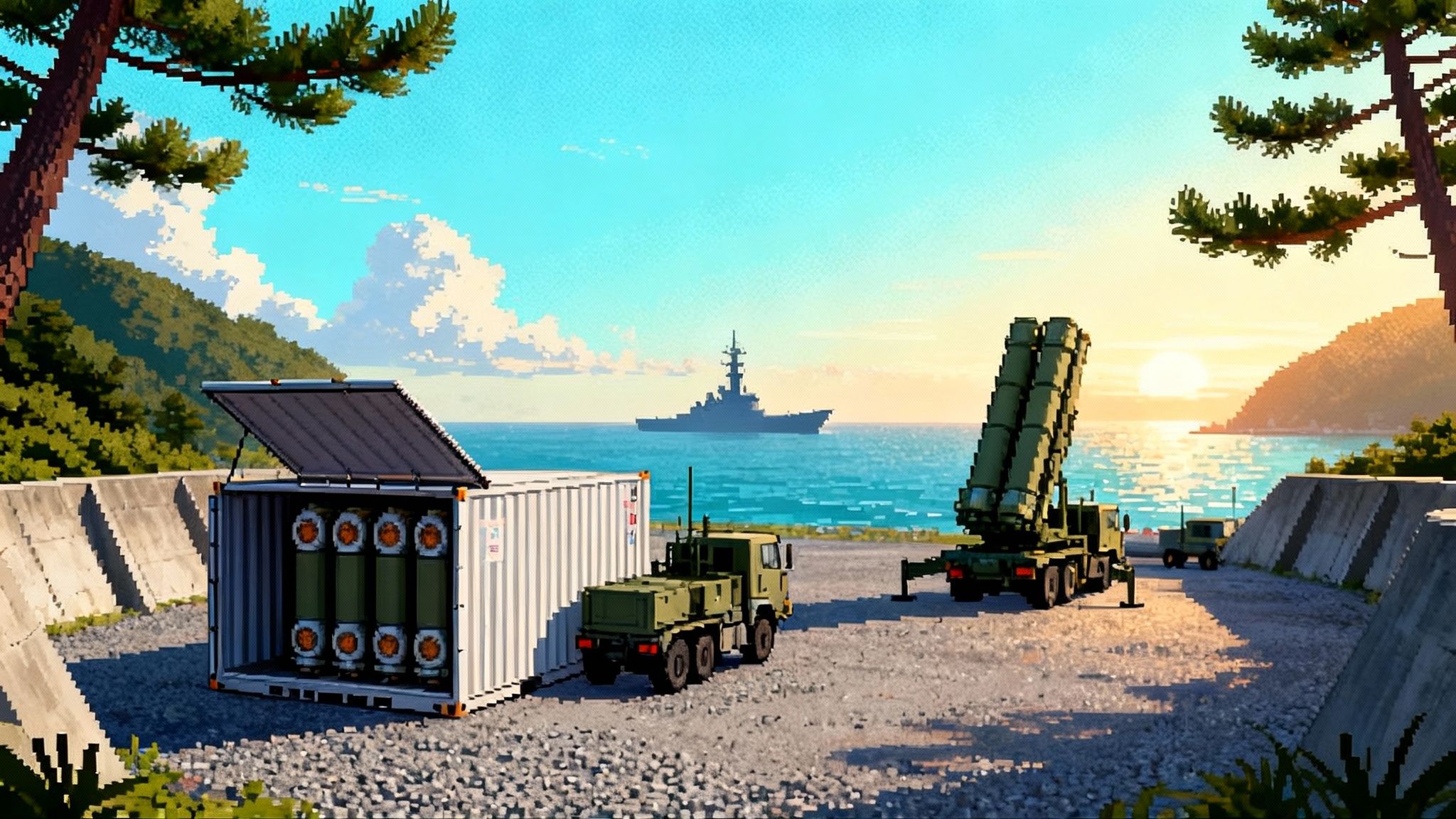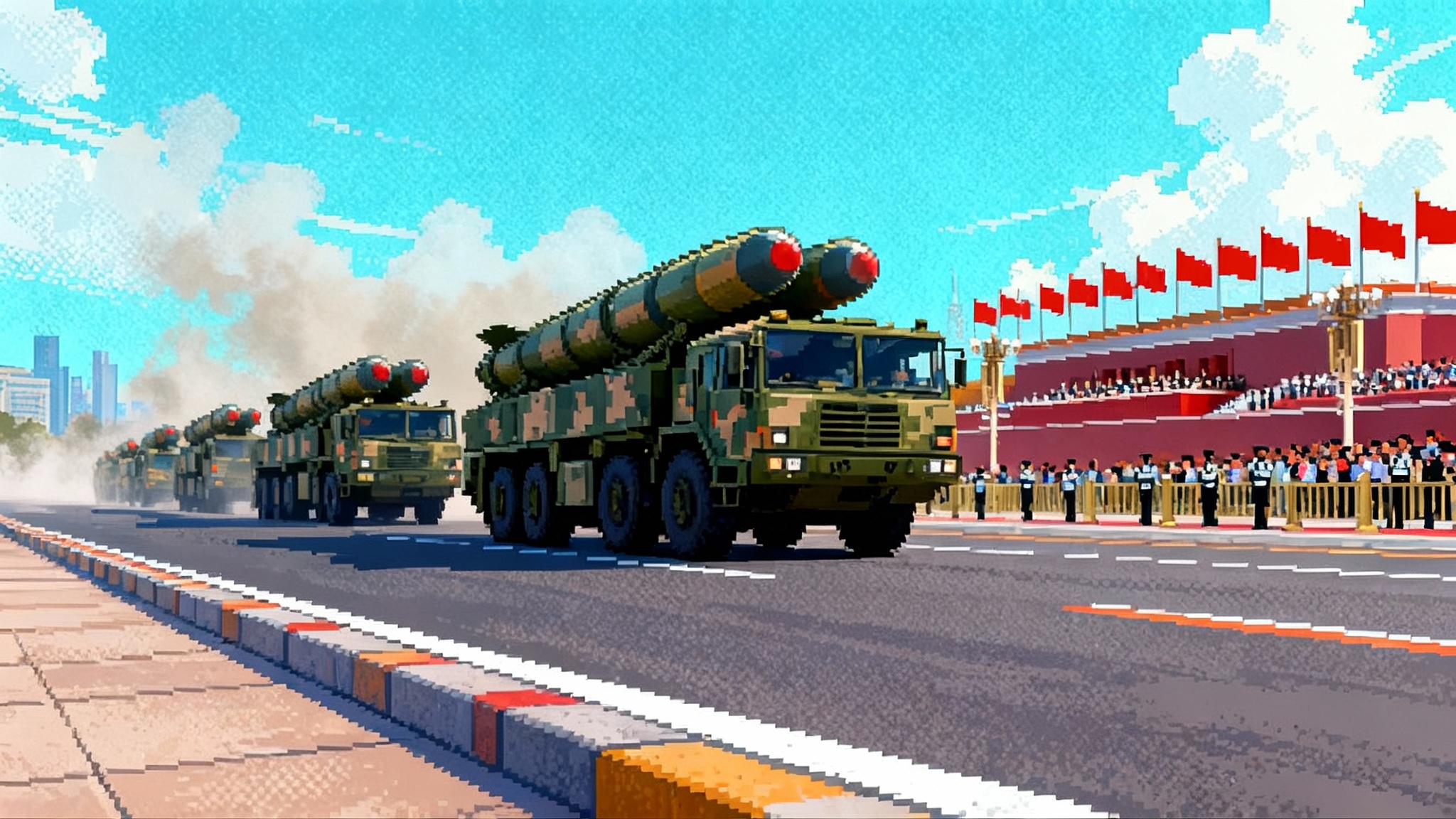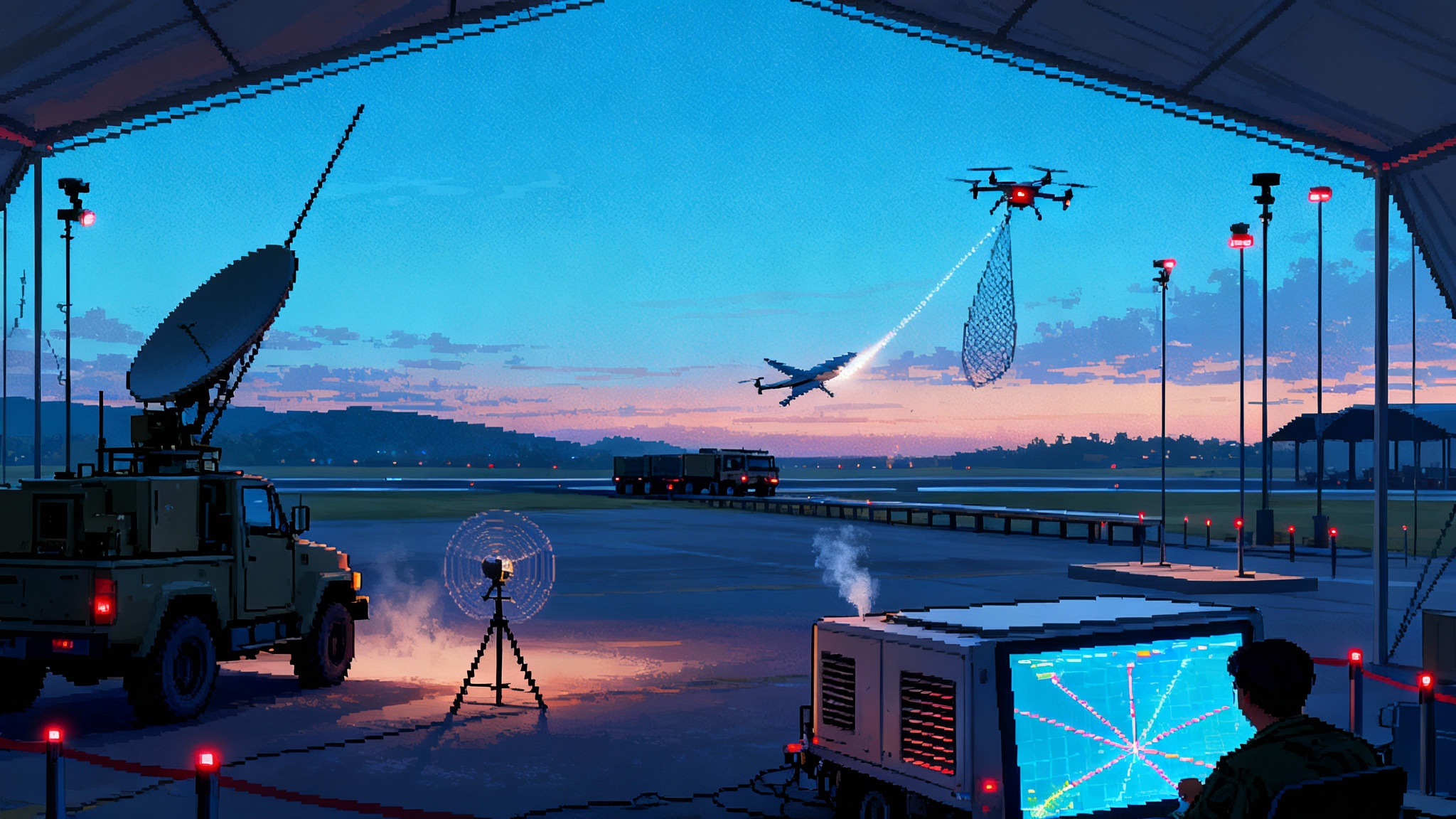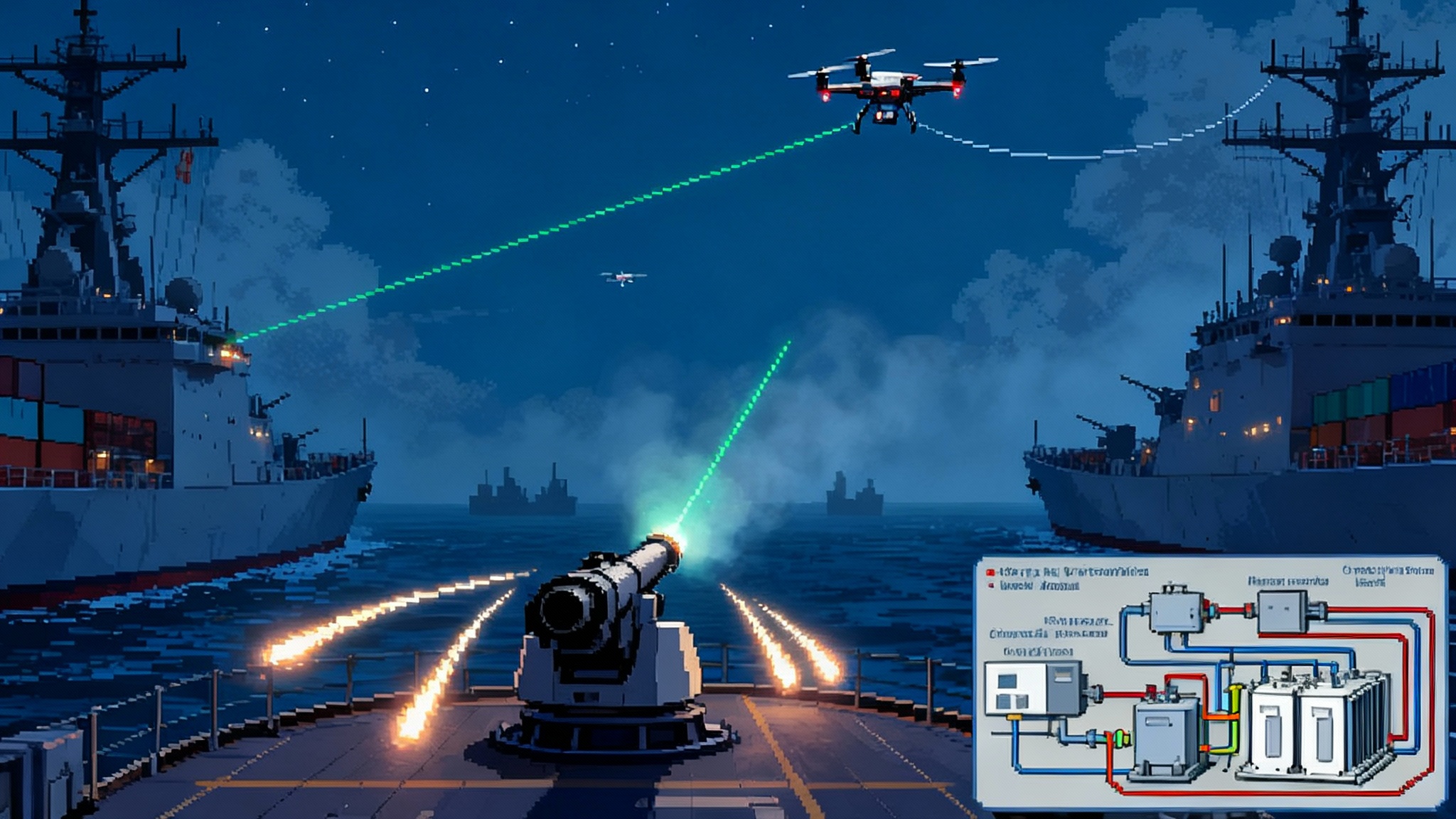Typhon in Japan and the Return of Land-Based Deep Strike
The U.S. Army’s Typhon launchers just appeared in Japan, putting Tomahawk and SM-6 back on land along the First Island Chain. Here is how the system’s loadout, kill-chain integration, mobility, and escalation risks reshape Indo-Pacific deterrence—and why Europe is next.

A new silhouette on the First Island Chain
A truck rolls into a coastal base in western Japan carrying a plain 40‑foot container. It looks like any shipping box until its roof clamshells open to reveal four vertical launch cells. Inside sit missiles sailors know well but land forces have not fielded since the INF era: Tomahawk and SM‑6. The U.S. Army calls the system Mid‑Range Capability. Everyone else knows it as Typhon. Its debut in Japan during the Resolute Dragon exercise signals a shift in how the United States and Japan intend to hold Chinese forces at risk from ashore along the First Island Chain. The message is simple. Mobile, land‑based deep strike is back where geography favors it most, and it is networked into a much bigger allied kill chain than before. Reuters reported the deployment in Japan, noting that the launcher will depart after the drills but the precedent is now set.
What Typhon really is
At heart Typhon is a containerized Mk 41 vertical launch system on a truck, tied to a battery operations center and supported by command, communications, and sustainment vehicles. Each launcher carries four Mk 41 cells in an ISO container. The Army designed the battery to be modular. Launchers and command elements can disperse by roads and ferries. Crews can emplace and shoot from austere sites with limited preparation.
The missiles are the point. Typhon fires two families of proven rounds.
- Tomahawk: land‑attack cruise missiles that can fly low, navigate around terrain and defenses, and strike fixed targets at theater ranges. Block V variants add modern seekers, navigation, and data links. A maritime strike variant exists, allowing engagement of ships if targeting is reliable.
- SM‑6: a multi‑mission missile with a large booster, an active seeker, and the ability to engage aircraft and cruise missiles and, crucially for Typhon, to strike ships at sea. In land service, SM‑6 brings a fast, high‑end anti‑ship option and a limited area air defense layer around the battery. It does so with a flight profile and seeker already familiar to Aegis operators.
Typhon is not a silver bullet. Four cells per launcher means small magazines. Reloads are bulky and time consuming, and the missiles are not cheap. But the system repurposes mature Navy weapons and launch hardware without waiting years for a bespoke Army missile. That is the point. Typhon fills the range gap between the Army’s Precision Strike Missile and its hypersonic Long‑Range Hypersonic Weapon, using missiles allies already operate at sea.
The kill chain that makes it lethal
Missiles are only as good as the tracks they get. Typhon’s real value in Japan is how it can plug into a combined U.S.–Japan sensor and command network.
- Maritime sensors: U.S. and Japanese Aegis destroyers, E‑2D early warning aircraft, P‑1 and P‑8 patrol aircraft, and space‑based maritime domain awareness can all contribute tracks on surface targets. Land‑based over‑the‑horizon radars and national technical means supply persistence.
- Air and ground sensors: F‑35s, ground radars, and passive electronic support sensors can generate cues and refine targeting. Japan’s growing constellation of satellites and its push toward joint all‑domain C2 complement U.S. Joint All‑Domain Command and Control efforts.
- Data links and C2: Link‑16, satellite communications, and emerging cross‑domain fusion nodes inside the U.S. Army’s Multi‑Domain Task Forces give Typhon access to joint targeting cycles. Japan’s new joint operations command, stood up to integrate across the Self‑Defense Forces, should shorten the loop.
In practice the battery may receive a maritime composite track from an allied destroyer, a patrol aircraft, or a fused joint node. SM‑6 can prosecute that target with a seeker comfortable in a cluttered maritime environment. Tomahawk can fly coordinated routes to fixed infrastructure sites and arrive in volume. The key is not where the launcher sits but how well it is integrated into the allied sensor web that stretches from Hokkaido to the Northern Marianas.
Mobility and survivability under PLA eyes
The People’s Liberation Army has built an impressive surveillance and strike complex designed to find and hit big fixed nodes. Typhon was built to avoid being one.
- Dispersed footprint: Launchers, command vehicles, and sustainment trucks can spread out across road networks, ports, and small bases. A launcher can park under tree lines, in quarry lots, or beside warehouses. If the enemy does not know which container hides Mk 41 cells, the search problem grows.
- Emissions control: The battery can run with strict radio discipline and use preplanned fire missions or burst communications windows. External targeting reduces the need for organic radar emissions that give away position.
- Shoot and scoot: Firing from a prepared pad, then relocating within minutes, complicates missile and loitering munition attacks cued by launch detection.
- Deception: Dummy containers, heat decoys, and electronic feints can soak up ISR and munitions. In a theater crowded with logistics containers and civilian trucks, deception has more places to hide.
Survivability is not assured. China’s growing satellite constellations, high‑altitude UAVs, and long‑range missiles threaten any known launcher. Cheap quadcopter swarms will not reach Typhon on Japan’s main islands, but heavier loitering munitions and cruise missiles might. Integrated air defense cover from Japanese and U.S. systems, along with the SM‑6’s own defensive utility, gives the battery a better chance to live between moves. Typhon does best as one node in a dispersed, deceptive, and resilient network of allied long‑range fires, not as a standalone centerpiece.
Escalation risks of land‑based deep strike
Putting Tomahawk on Japanese soil is politically sensitive. It sharpens deterrence by raising credible costs to the PLA Navy and to fixed military infrastructure ashore. It also raises thorny questions about thresholds.
- Geographic signaling: From southwestern Japan, Tomahawk can reach a wide swath of coastal China. Even if the exercise rotation is temporary, Beijing must consider that launchers could reappear with little warning. That uncertainty is part of deterrence.
- Target ambiguity: Tomahawk and SM‑6 are conventional. There is no nuclear ambiguity in these Army rounds. The risk stems from target selection. Strikes on air bases, logistics hubs, and command nodes inside China could be seen as horizontal escalation even in a maritime fight. That perception can drive early salvos from the other side against launchers and their host bases.
- Alliance equities: Japan’s adoption of a counterstrike concept complicates, and clarifies, the politics. If Tokyo decides certain PLA assets threaten survival, allied batteries on Japanese soil become part of a national response that is both legally and publicly framed. Coordination mechanisms will matter when timelines are measured in minutes.
The stabilizing argument is that land‑based launchers on allied soil reduce dependence on a few large U.S. ships for theater strike. Distributing magazines across land and sea raises the adversary’s cost to disarm the alliance in one blow. The destabilizing argument is that mobile ground launchers close to the fight compress warning timelines and tempt both sides to go first. Both can be true. Managing that tension is the work of doctrine, exercises, and transparent signaling.
How Beijing is likely to answer
China has options, military and political.
- ISR surge: More satellite tasking over Japan during crises, paired with cyber operations against logistics and C2 networks that sustain a battery on the move.
- Preemption logic: Pressure on Tokyo and Washington through public and private channels warning that known Typhon deployments create “legitimate targets” inside Japan. Expect missile brigades drilled against dummy containers and road junctions.
- Counter‑mobility: Attacks on ferries, ports, and bridges that enable battery displacement, plus mining or threatening sea lanes that a battery might need to cross between islands.
- Electronic warfare: GPS jamming and spoofing against Tomahawk navigation and against the communications that feed the kill chain.
- Missile defense adaptation: More point defenses at key bases and nodes, including hardening, decoys, and mobile short‑range air defenses to complicate Tomahawk raids.
None of these negate Typhon by themselves. They force the alliance to invest in concealment, deception, continuous mobility, and rapid reconstitution. That is already happening.
Proof under fire drills: Talisman Sabre 2025
The value of all this integration is best seen in combined exercises. During Talisman Sabre 2025 in Australia, the U.S. Army’s 3rd Multi‑Domain Task Force deployed Typhon and conducted the first MRC SM‑6 live fire outside the United States, sinking a target ship while validating combined targeting and C2 with the Australian Army. The U.S. Army’s official account captured the milestone and the allied integration it required. The Army release on the live fire underlined that Typhon is not just a launcher. It is a node that only matters if sensors, shooters, and commanders can work together quickly.
For Japan, that Australian vignette matters. It shows how a battery that never turns on its own radar can still get a quality track, fire an SM‑6 at sea, and then displace under allied air cover. Replicate that along the Ryukyus with U.S. and Japanese units and Beijing’s calculus gets harder.
Europe takes notes: Germany moves toward Typhon
Asia is not the only theater rediscovering land‑based deep strike. Berlin has signaled its intent to procure Typhon as an interim solution while Europe develops its own long‑range options. The logic is similar to Japan’s. Germany wants a credible conventional deep‑strike capability soon, without waiting a decade for an indigenous system. Typhon’s appeal is that it leverages existing U.S. missile production lines, proven launch hardware, and a deployment model that is modular and road mobile. It gives the Bundeswehr a way to threaten high‑value military nodes at operational depth, complicating Russian planning and complementing air‑launched strike.
If finalized, a German Typhon would accelerate a European shift back to ground‑launched theater strike as a normal part of NATO deterrence. It would also encourage common training, doctrine sharing, and perhaps shared sustainment with U.S. Army batteries. Europe’s emerging long‑range strike consortiums are likely to coexist with, not replace, an interim Typhon buy. In the near term, that creates a common playbook across two theaters.
The next 12–24 months: basing, doctrine, industry
What changes next will come fast. Expect movement across three fronts.
- Basing and presence
- Episodic in Japan: The initial appearance at Resolute Dragon sets the pattern. Expect episodic rotations to Japanese bases timed to major exercises, paired with short‑notice deployments that test reception and onward movement to austere sites. The politics are easier with temporary presence. The operational effect is similar if rotations are frequent and unpredictable.
- Philippines and Australia as anchors: Rotations through the Philippines will likely continue as bilateral access matures. Australia will remain the ally most willing to host live fires, which matters for confidence in the kill chain and for logistics rehearsal.
- Europe stands up: If Germany signs, fielding a first battery on German soil in the next two years is achievable given existing production. Initial focus will be on integration with NATO targeting and air defense, not on raw missile counts.
- Doctrine and integration
- Joint maritime strike from land becomes routine: U.S. and Japanese staffs will write and rehearse playbooks where an Army battery ashore is a standard shooter in maritime kill chains. Expect more cross‑decking of liaison teams between Army MDTFs, JMSDF Aegis ships, and JASDF air defense units.
- Civil‑military mobility agreements: Road movement, ferry priority, and shelter access for containerized launchers will need peacetime arrangements with local governments. Exercises will increasingly include these real logistics constraints.
- Deception and emissions control as core tasks: Units will treat decoy management and EM hygiene like gunnery. Expect purpose‑built decoy containers, rapidly erected camouflage, and tighter OPSEC protocols in every exercise.
- Industry and magazines
- Tomahawk and SM‑6 throughput: Production of both missiles has already been climbing. The demand signal from land units and allies will reinforce multiyear buys. The bottleneck will be seekers, propellant, and qualified labor. Expect public targets for annual output and more co‑production or final assembly in allied countries over time.
- Launchers and spares: The containerized Mk 41 approach is relatively straightforward to scale. Fielding more battery kits will still require long‑lead electronics and command vehicle integration. Industry will tout delivery timelines measured in quarters, not years, but crews and training areas will be the real pacing items.
- Training targets and ranges: You cannot validate a maritime strike battery without realistic targets and ranges that allow over‑water shots. Australia will host many of these events. Japan will expand complex dry runs and simulator work while navigating sensitive live‑fire politics.
What to watch
- Repeat rotations into Japan: If Typhon appears at multiple Japan‑based exercises in 2026, the “episodic but routine” model will be real.
- Japanese counterstrike doctrine in practice: Watch how Tokyo’s new joint command structures incorporate allied long‑range fires and how quickly approval chains move in drills.
- German contracting and fielding: A signed letter of offer and acceptance, followed by the first launcher arrivals, will set Europe’s timeline.
- PLA ISR behavior: Increased satellite passes, UAV flights, and public warnings during allied rotations will show Beijing’s priorities and thresholds.
- Magazine growth: Concrete numbers on annual Tomahawk and SM‑6 output will indicate how fast land batteries can scale beyond a handful of launchers.
The bottom line
With Typhon in Japan, the United States and its allies are pushing land‑based deep strike back into the maritime fight, where geography and roads can be as powerful as sea room. The system’s technical loadout is simple and mature. Its real strength is as a mobile, networked shooter inside a combined kill chain that can pass quality tracks across services and borders. That is why a temporary rotation still matters. It tests the plumbing that turns four launch cells into theater‑level leverage.
The risks are real. Ground launchers near the front compress timelines and tempt preemption. They demand serious investments in deception and mobility. But the benefits are hard to ignore. Distributing strike magazines across land and sea makes allied forces harder to disarm. It raises the cost of aggression early and gives policymakers more scalable options than sending in large ships alone.
Australia’s recent live fire proved the concept under exercise pressure. Germany’s interest shows the model is contagious. Over the next two years, expect more batteries, more routine integration, and more of those anonymous containers appearing where adversaries would least like them to be. That is deterrence by distribution, and it is arriving by truck.



